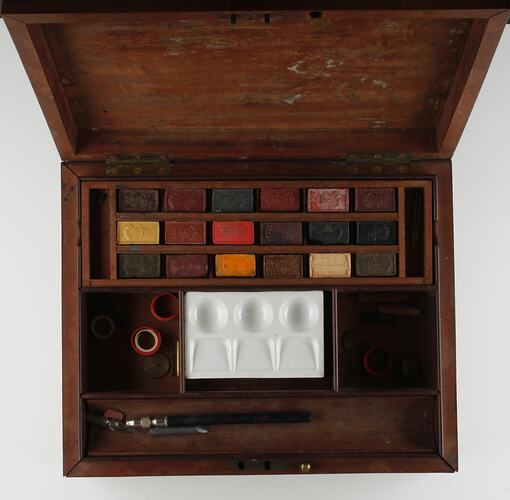Summary
Alternative Name(s): Paintbox, Watercolour Box, Paint Pallette
Wooden paint box containing a pallette of watercolour paints and other painting accessories such as nibs, crayons, erasers and tubes of colour. Although the maker's name has been lost, the paints are labelled with several manufactuers' names, including G. Rowney & Co. Ltd, Newman's and C. Roberson & Co. Ltd, all London-based firms.
The box has not been dated precisely, but the previous owner believed it to be Victorian. It is likely to have been mid-Victorian or later Victorian, based on the style of the box and the watercolour cakes. The dates of the box contents vary, but some date to the first half of the 20th century. A tube of paint labelled 'C. Roberson & Co. Ltd' reflects a name only used by this company 1907-1987. A tube made by manufacturer Newman's gives an address at 24 Soho Square, which the company occupied between 1801 and 1937. Another Newman's tube, labelled 'Marlborough St', may indicate a date of 1938-1940, as the company was then at 6 Great Marlborough St. A further tube, labelled 'G. Rowney & Co Ltd' suggests a date of 1923-1985, when the name 'George Rowney & Co Ltd' was used.
The paint box was acquired by Museum Victoria from a person who imported it from England. It is likely to have been made there (although a box of crayons and a tube of paint are from France), but its provenance is otherwise unknown.
Physical Description
Wooden paint box with hinged lid and accessories. Original paper label inside lid has been removed. Inside box is a removable tray containing compartments for 18 cakes of watercolour paint. Most are unused, and still carry the original imprints from their moulds. A separate white ceramic tray with three circular depressions and three open-ended depressions would be used to mix colours. The tray is removed by pressing one end, tipping its shelf for easy removal. Another removable tray accommodates pens and pencils - a shaft for removable nibs, a thick lead, a nib and a small red eraser were housed in this tray when acquired. Two other compartments in the box contain five circular objects (three red, two white), apparently made of a polymer, that may function as paper clips. Five brass discs with pins in their centres - perhaps an early form of thumb tack - may also be used to secure paper. When the paint tray is removed, a compartment beneath is revealed containing five watercolour cakes still in their original packaging. Three more are loose, one of which is broken. A rectangular box papered with blue, with a removable lid, contains several heavy, square leads (called 'crayons' on box). A brass pin in the front edge of the box is pulled up to allow a single-compartment drawer to open at the front. The drawer contains four tubes of paint (partly used), two erasers (very worn from use), a stick of pink chalk, two wooden sticks (one thin, one thick), a small piece of chamois leather and a small white-papered rectangular box with removable lid containing 14 fine paint brush ends.
Significance
The paint box is considered significant as a representative example of 19th century artists' supplies. The manufacturers of some of the contents adds to its significance: Charles Roberson, Newman's and G. Rowney & Co Ltd - all significant manufacturers of artists' supplies based in London in the 19th and first half of the 20th centuries. Charles Roberson (1799-1876) is considered 'one of the most important colourmen in London in the nineteenth century', and the Fitzwilliam Museum in the Hamilton Kerr Institute at the University of Cambridge holds a significant archive documenting the operations of Charles Roberson & Co. and its relationships with customers and suppliers. The archive is said to be the largest artists' colourman's archive in the United Kingdom, covering the period from 1820 to 1944. It includes information on the materials and techniques of many of the leading 19th and 20th century British artists including 'all the artist members of the Pre-Raphaelite Brotherhood, Leighton, Alma Tadema, Watts, Whistler, Tissot, William Morris and many other members of the Royal, Cambrian, Hibernian & Scottish Academies'.
Charles Roberson opened his first shop in Long Acre, London, in 1819, selling artists' materials. His business soon became 'one of the most influential colour houses in London, its customers spanning the social spectrum from Queen Victoria to theatrical scene painters'. Royal Academicians were included on their account books, as well as leading designers of the period and members of the social elite. The business moved to 99 Long Acre in 1853 (where it was situated when the Museum's paint box was made), and remained there until 1937.
More Information
-
Collecting Areas
-
Acquisition Information
Purchase
-
Place & Date Made
-
Inscriptions
Inscribed on box of leads: '1 Douzaine / CRAYONS / POUR / DESSIN / CARRES BLANCS [white, square, for drawing] / No. 3 / CONTE / A / PARIS / (FRANCE)' Inscribed on watercolour cake packaging: 'NEWMAN'S / [colour name] / 24, SOHO SQUARE.' Inscribed on paint tube: 'NEWMAN'S / [colour name] / Marlborough Street W.1' Inscribed on paint tube: '[colour name] / C. ROBERSON & CO Ltd. / 99 Long Acre, / LONDON, ENGLAND' Inscribed on paint tube: 'G. ROWNEY & Co. Ltd. / ARTISTS' WATER COLOURS. / LONDON, ENGLAND / FRENCH ULTRA / Outremer francais / Series / 3192 / A. / [stamped on] Y.R.'
-
Classification
-
Category
-
Discipline
-
Type of item
-
Overall Dimensions
279 mm (Width), 99 mm (Depth), 99 mm (Height)
Measured with box closed. When box open, height is 286 mm.
-
Dimensions
279 (Length), 99 (Width), 99 (Height)
Measurement From Conservation. Measured with box closed. When box open, height is 286 mm.
-
References
'British artists' suppliers, 1650-1950', National Portrait Gallery, [Link 1] accessed 12/10/2011
-
Keywords
